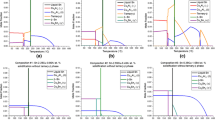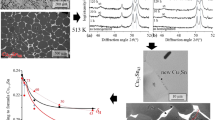Abstract
Controlling the size, dispersion, and stability of intermetallic compounds in lead-free solder alloys is vital to creating reliable solder joints regardless of how many times the solder joints are melted and resolidified (reflowed) during circuit board assembly. In this article, the coarsening behavior of Cu x Al y and Cu6Sn5 in two Sn-Cu-Al alloys, a Sn-2.59Cu-0.43Al at. pct alloy produced via drip atomization and a Sn-5.39Cu-1.69Al at. pct alloy produced via melt spinning at a 5-m/s wheel speed, was characterized after multiple (1-5) reflow cycles via differential scanning calorimetry between the temperatures of 293 K and 523 K (20 °C and 250 °C). Little-to-no coarsening of the Cu x Al y particles was observed for either composition; however, clustering of Cu x Al y particles was observed. For Cu6Sn5 particle growth, a bimodal size distribution was observed for the drip atomized alloy, with large, faceted growth of Cu6Sn5 observed, while in the melt spun alloy, Cu6Sn5 particles displayed no significant increase in the average particle size, with irregularly shaped, nonfaceted Cu6Sn5 particles observed after reflow, which is consistent with shapes observed in the as-solidified alloys. The link between original alloy composition, reflow undercooling, and subsequent intermetallic coarsening behavior was discussed by using calculated solidification paths. The reflowed microstructures suggested that the heteroepitaxial relationship previously observed between the Cu x Al y and the Cu6Sn5 was maintained for both alloys.














Similar content being viewed by others
Notes
MARL, Iowa State University, Ames, IA, USA. http://www.marl.iastate.edu/FEISEM.html
LSMF, Purdue University, West Lafayette, IN, USA. https://ag.purdue.edu/arp/Microscopy/Pages/default.aspx
References
J.W. **an, S.A. Belyakov, T.B. Britton, and C.M. Gourlay: J. Alloys Compd., 2015, vol. 619, pp. 345–55.
J.W. **an, S.A. Belyakov, and C.M. Gourlay: J. Electron. Mater., 2015, vol. 45, pp. 69-78.
A.J. Boesenberg, I.E. Anderson, and J.L. Harringa: J. Electron. Mater., 2012, vol. 41, pp. 1868-81.
K.N. Reeve, S.M. Choquette, I.E. Anderson, and C.A. Handwerker: Metall. Mater. Trans. A, 2016, DOI:10.1007/S11661-016-3738-6.
W.S. Rasband: ImageJ (U. S. National Institutes of Health, Bethesda, Maryland, 1997–2016), http://www.imagej.nih.gov/ij/. Accessed 10 Aug 2016.
B. Arfaei, M. Benedict, and E.J. Cotts: J. Appl. Phys., 2013, vol. 114, p. 173506.
A. Ohno and T. Motegi: J. Japan Inst. Met., 1973, vol. 37, pp. 777-80.
D. Swenson: J. Electron. Mater., 2007, vol. 18, pp. 39-54.
I.E. Anderson, J.W. Walleser, J.L. Harringa, F. Laabs, and A. Kracher: J. Electron. Mater., 2009, vol. 38, pp. 2770-9.
K. Sweatman, T. Nishimura, S.D. McDonald, M. Whitewick, and K. Nogita: SMT Mag., 2014, pp. 30-40.
K.N. Reeve, I.E. Anderson, and C.A. Handwerker: J. Electron. Mater., 2015, vol. 44, pp. 842-66.
B. Vonnegut: J. Colloud Sci., 1948, vol. 3, pp. 563-9.
G M Pound and V.K. La Mer: J. Am. Chem. Soc., 1952, vol. 74, pp. 2323-32.
D. Turnbull: J. Chem. Phys., 1950, vol. 18, p. 768.
D. Turnbull: J. Chem. Phys., 1950, vol. 18, p. 769.
J.H. Perepezko: Mater. Sci. Eng., 1984, vol. 65, pp. 125-35.
I.M. Lifshitz and V.V. Slyozov: J. Phys. Chem. Solids, 1961, vol. 19, pp. 35-50.
C. Wagner: Z. Elektrochem., 1961, vol. 65, pp. 581-91.
M. Koca, N.O. Koca, and R. Koç: J. Math. Phys., 2010, vol. 51, pp. 1-20.
E.H. Kisi and J.D. Browne: Acta Crystallogr. Sect. B Struct. Sci., 1991, vol. 47, pp. 835-43.
L. Arnberg and S. Westman: Acta Crystallogr. Sect. A, 1978, vol. 34, pp. 399-404.
Acknowledgments
This work was supported by Ames Laboratory (USDOE), Purdue University, and Nihon Superior through Ames Lab Contract No.DE-AC02-07CH11358. Additionally, this research was conducted with government support under and awarded by the DoD Air Force Office of Scientific Research, National Defense Science and Engineering Graduate (NDSEG) Fellowship, 32 CFR 168a. The research group is grateful for the support and helpful communications provided by Nihon Superior, and for the assistance of Fukuda Co. in producing the drip atomized solder sample presented in this paper. The group would also like to thank Kevin Dennis (dennis@ameslab.gov) of Ames Laboratory for help in producing the melt spun ribbon alloy, Warren Straszheim (wesaia@iastate.edu) of Iowa State University’s MARL microscopy facility for assistance and expertise in the use of the field emission SEM, and John Holaday (jholaday@purdue.edu) of Purdue University for calculating the discussed Thermo-Calc ternary solidification paths.
Author information
Authors and Affiliations
Corresponding author
Additional information
This manuscript has been authored, in whole or in part, under Contract No. DE-AC02-07CH11358 with the U.S. Department of Energy. The U.S. government retains and the publisher, by accepting the article for publication, acknowledges that the U.S. government retains, a nonexclusive, paid-up, irrevocable, worldwide license to publish or reproduce the published form of this manuscript, or allow others to do so, for U.S. government purposes.
Manuscript submitted March 17, 2016.
Rights and permissions
About this article
Cite this article
Reeve, K.N., Choquette, S.M., Anderson, I.E. et al. Rapid Solidification of Sn-Cu-Al Alloys for High-Reliability, Lead-Free Solder: Part II. Intermetallic Coarsening Behavior of Rapidly Solidified Solders After Multiple Reflows. Metall Mater Trans A 47, 6526–6541 (2016). https://doi.org/10.1007/s11661-016-3739-5
Received:
Published:
Issue Date:
DOI: https://doi.org/10.1007/s11661-016-3739-5




